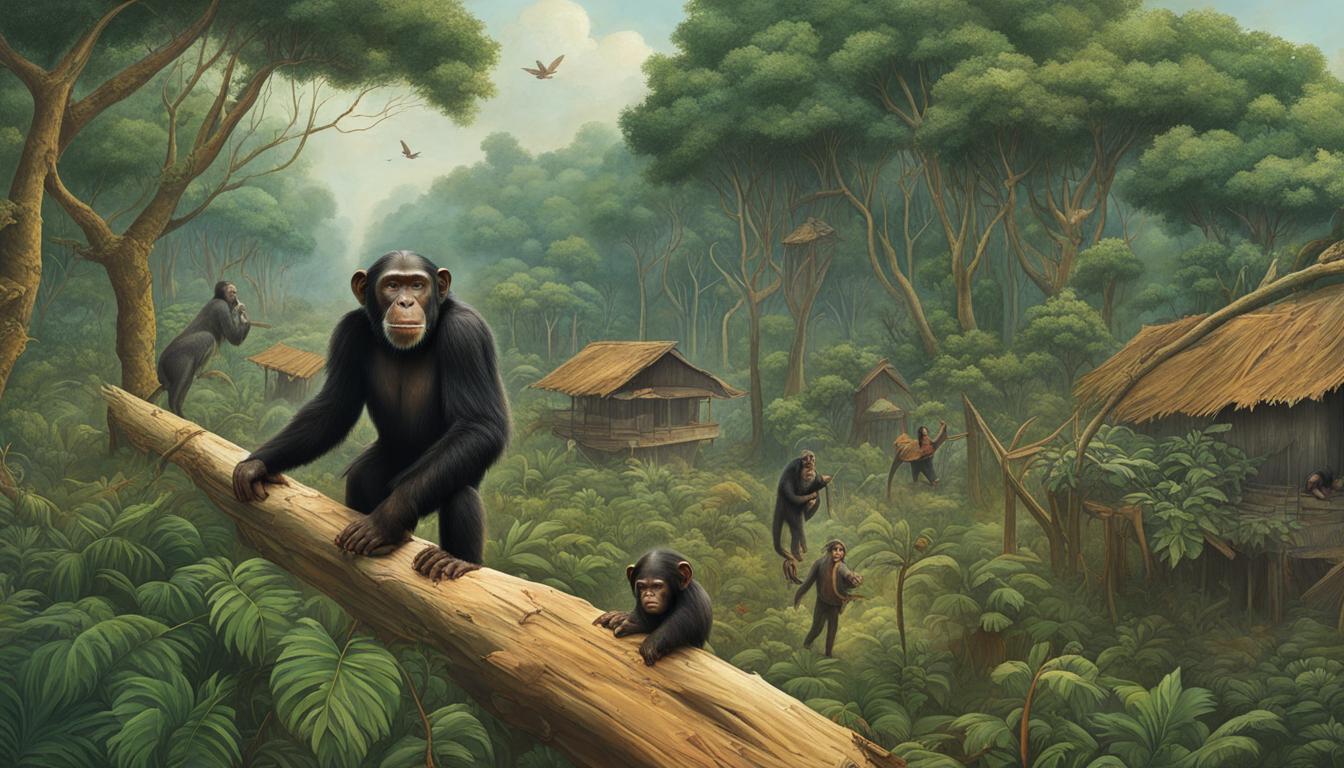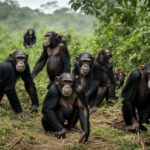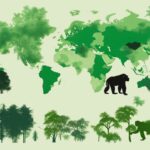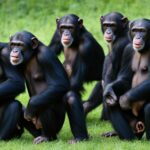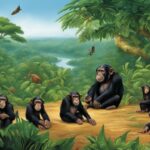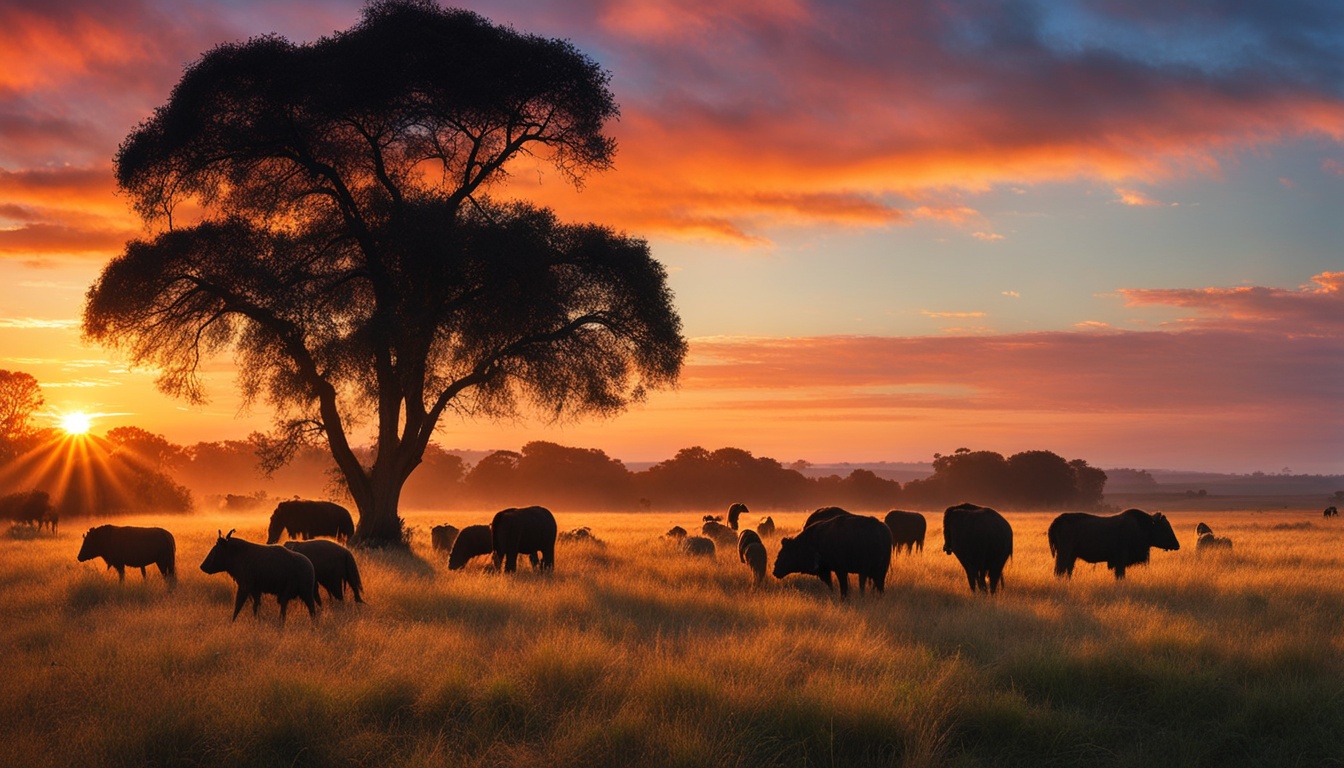Chimpanzees, our close relatives, play a vital role in maintaining the diversity of Central Africa’s forests. However, all four chimpanzee subspecies are now endangered due to the historical impact of human activities. The human influence on chimpanzee populations over time has resulted in significant historical changes and a decline in their numbers.
Human activities such as habitat loss, hunting, and disease have posed significant threats to chimpanzees. These anthropogenic factors have resulted in a historical decline in chimpanzee populations. Habitat loss, caused by human actions like deforestation for agriculture and logging, disrupts the natural behavior of chimpanzees and reduces their access to food and shelter.
Hunting, particularly for bushmeat, poses a severe danger to chimpanzees. The slow reproductive rate of chimpanzees further exacerbates these threats, as it takes many years for the population to recover from the loss of breeding individuals. Disease transmission from humans to chimpanzees is also a significant concern, as chimpanzees are susceptible to many human illnesses.
To address these challenges, organizations and governments are implementing conservation efforts, developing action plans, improving wildlife protection, and educating local communities about the importance of conserving chimpanzees. Efforts are also being made to address habitat loss and promote sustainable practices.
In this article, we will explore the various threats faced by chimpanzees due to human activities, the consequences of these threats on their populations, and the conservation efforts being undertaken to protect them. We will also highlight the individual actions that you can take to contribute to the conservation of chimpanzees and their habitats.
Threats to Chimpanzees
Chimpanzees, our close relatives, face numerous threats as a result of human activities. These threats include habitat loss, disease, and hunting, leading to significant declines in chimpanzee populations. The slow reproductive rate of chimpanzees further exacerbates these challenges, making their conservation crucial for their long-term survival.
Habitat Loss:
The primary threat to chimpanzees is habitat loss caused by human activities, including deforestation for agriculture and logging. The destruction of their natural habitat disrupts chimpanzees’ behavior and makes it challenging for them to find food and shelter. The loss of forested areas also limits their habitat connectivity, leading to increased competition for limited resources.
Disease:
Chimpanzees are susceptible to many of the same diseases as humans and can easily contract illnesses from humans. The encroachment of human populations into chimpanzee habitats increases the risk of disease transmission. Even common human diseases, such as the common cold, can have devastating effects on chimpanzee populations. Outbreaks of diseases, such as Ebola, have had a severe impact on chimpanzees, with mortality rates reaching as high as 95%.
Hunting:
Hunting, particularly for bushmeat, poses a significant danger to chimpanzee populations. Chimpanzees are often targeted by hunters for their meat, which is highly valued in some communities. The demand for bushmeat has increased with the growth of human populations, leading to increased hunting pressure on chimpanzees. The killing of adult chimpanzees disrupts social structures within chimpanzee communities and further threatens their survival. Given their slow reproductive rate, it takes many years for the population to recover if an adult chimpanzee is killed.
To visualize the threats faced by chimpanzees, here is a table summarizing the main threats and their impacts:
| Threat | Impact |
|---|---|
| Habitat Loss | Disruption of behavior and decreased availability of food and shelter |
| Disease | Risk of disease transmission, high mortality rates during outbreaks |
| Hunting | Loss of breeding individuals, disruption of social structures |
| Slow Reproductive Rate | Long recovery time for population after loss of adults |
Impact of Habitat Loss
Habitat loss resulting from human activities, such as deforestation for agriculture and logging, has had a profound impact on chimpanzee populations. Chimpanzees rely on forested areas for their food, shelter, and social interactions, making habitat loss a significant threat to their survival. The conversion of land for agriculture and logging not only diminishes the availability of essential resources for chimpanzees but also disrupts their natural behavior and ecological balance.
Deforestation, driven by the expansion of agriculture and the demand for timber, has led to the destruction of extensive chimpanzee habitats. As trees are cleared, chimpanzees lose access to the fruits, nuts, and vegetation they depend on for sustenance. Moreover, their ability to find suitable shelter and form cohesive social groups is severely compromised when their natural environment is disrupted.
The impact of habitat loss on chimpanzee populations is further exacerbated by the disconnection and fragmentation of their remaining habitats. As large stretches of forest are cleared, the remaining patches become isolated, making it challenging for chimpanzees to move freely and find sufficient resources. This fragmentation reduces genetic diversity and poses long-term threats to the survival of these endangered primates.
To visualize the extent of habitat loss, the table below presents a comparison of forest cover and chimpanzee populations in select regions:
| Region | Forest Cover (square miles) | Chimpanzee Population |
|---|---|---|
| Congo Basin | 1,800,000 | approximately 150,000-250,000 |
| West Africa | 350,000 | approximately 13,000-21,000 |
| Eastern Africa | 700,000 | approximately 15,000-25,000 |
The data presented in the table highlights the significant forest cover in the Congo Basin, West Africa, and Eastern Africa, which are crucial habitats for chimpanzees. However, with increasing rates of deforestation, it is essential to take immediate action to protect these forests and their chimpanzee populations.
Consequences of Hunting
Hunting, especially for bushmeat, has had severe consequences for chimpanzee populations. Chimpanzees, our close relatives, have been targeted by hunters for their highly valued meat in certain communities. The demand for bushmeat has increased alongside growing human populations, resulting in increased hunting pressure on chimpanzees. Unfortunately, this has led to significant impacts on their numbers and overall well-being.
The consequences of hunting are twofold. Firstly, hunting can result in the death of breeding individuals, which has a direct negative effect on the reproductive capacity of chimpanzee populations. With their already slow reproductive rate, it becomes challenging for the population to recover from these losses, leading to a decline in their overall numbers.
Secondly, hunting disrupts the social structures within chimpanzee communities. Chimpanzees live in complex social groups, with intricate hierarchies and relationships. When individuals are hunted and killed, it creates a void in these social structures, potentially destabilizing the community dynamics.
To put the consequences of hunting into perspective, imagine a situation where key leaders and experienced members of a human community are continually taken away. This would undoubtedly have a profound impact on the functioning and well-being of the community as a whole. The same logic applies to chimpanzees, where individuals play essential roles in maintaining social cohesion, passing on knowledge, and ensuring the survival of the group.
The slow reproductive rate of chimpanzees further exacerbates the consequences of hunting. A female chimpanzee typically has a gestation period of around 8 months and typically gives birth to a single offspring at a time. This lengthy reproductive cycle, coupled with the loss of breeding individuals to hunting, means that it takes many years for the population to recover from such losses.
| Consequences of Hunting on Chimpanzee Populations |
|---|
| The direct killing of breeding individuals |
| Disruption of social structures within chimpanzee communities |
| Challenging recovery due to slow reproductive rate |
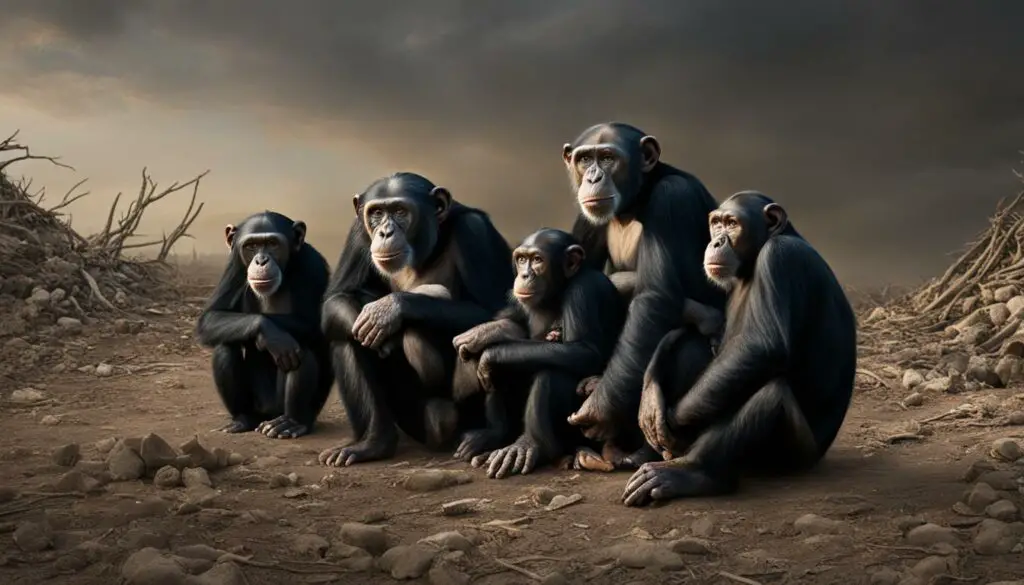
Disease transmission from humans
Chimpanzees, our close relatives, are highly susceptible to diseases that affect humans due to their close genetic relationship. As human populations continue to expand and encroach upon chimpanzee habitats, there is an increasing overlap between humans and chimpanzees, which elevates the risk of disease transmission. Even common human illnesses, such as the common cold, can have devastating effects on chimpanzee populations. However, disease outbreaks like Ebola pose an even greater threat, with mortality rates reaching as high as 95% for affected chimpanzees.
Disease transmission from humans to chimpanzees can occur through various means, including direct contact, respiratory droplets, or contaminated food and water sources. The transmission of pathogens can have severe consequences for chimpanzee populations, leading to illness, reduced reproductive success, and even death.
To protect chimpanzee populations and mitigate the risk of disease transmission from humans, disease prevention and management strategies are of utmost importance. Strict monitoring and regulation of human-chimpanzee interactions, such as minimizing direct contact and implementing proper sanitation practices in shared environments, can help reduce the likelihood of disease transmission. Additionally, raising awareness among local communities about the potential risks associated with the transmission of diseases from humans to chimpanzees is crucial for their protection.
For example, during the Ebola outbreak in Africa, efforts were made to educate communities about the importance of avoiding contact with infected individuals and wildlife to prevent the spread of the disease to chimpanzees and other vulnerable species.
Implementing strict protocols and guidelines for researchers, tourists, and individuals working in or visiting chimpanzee habitats can also help minimize disease transmission risks. This includes the use of personal protective equipment, regular health screenings, and adhering to strict hygiene practices.
Protecting chimpanzee populations from disease transmission requires a collaborative effort between communities, governments, conservation organizations, and researchers. By effectively managing the impact of human activities on chimpanzees and promoting responsible practices, we can protect their health and ensure their long-term survival.
Conservation efforts and successes
Various organizations and governments have been working together to protect chimpanzee populations. Efforts have been focused on collaborating with local communities, developing action plans, improving wildlife protection, and implementing sustainable land-use practices. These conservation initiatives aim to safeguard the well-being of chimpanzees and their habitats, ensuring their long-term survival.
One of the significant achievements of conservation efforts is the successful dismantling of illegal snare traps, which pose a significant threat to chimpanzees. These traps often cause severe injuries or death to chimpanzees that inadvertently encounter them. Through dedicated efforts, injuries caused by snares have been significantly reduced, enhancing the chances of chimpanzees’ recovery and population growth.
Additionally, conservation programs have implemented moratoriums on killing chimpanzees in specific areas. This critical step helps protect these endangered species from hunting and poaching activities that have devastated their populations. The moratoriums provide legal protection and deter individuals from engaging in activities that harm chimpanzees, allowing their numbers to stabilize and recover.
Community-based initiatives have also played a crucial role in protecting chimpanzees. By introducing alternative sources of income for farmers in local communities, these initiatives alleviate the reliance on activities that negatively impact the chimpanzee habitats. This collaborative approach creates a win-win situation, ensuring the well-being of both communities and chimpanzees.
Conservation efforts have yielded positive outcomes, with some chimpanzee populations showing signs of recovery. These successes are a testament to the collective dedication and commitment towards protecting these remarkable creatures. Communities are actively participating in conservation initiatives, raising awareness, and contributing to the preservation of chimpanzees and their habitats. The collaboration between organizations, governments, and local communities is vital for the continued success of these conservation efforts.
Individual actions to help chimpanzees
As an individual, you can make a significant impact on the conservation of chimpanzees by taking specific actions. By aligning your choices with sustainable practices and supporting conservation efforts, you can actively contribute to the protection of these remarkable creatures and their habitats.
Choose sustainable logging practices
One way to help chimpanzees is by opting for Forest Stewardship Council (FSC) certified paper and wood products. By doing so, you support sustainable logging practices that minimize deforestation and habitat destruction. Sustainable logging helps maintain the integrity of chimpanzee habitats, ensuring their long-term survival.
Donate to conservation organizations
Another impactful action is to donate to reputable conservation organizations and programs that are dedicated to protecting chimpanzees. Your financial support can contribute to crucial initiatives such as habitat restoration, anti-poaching efforts, research, and community education. By supporting these programs, you play an active role in safeguarding chimpanzees and their environments.
Support conservation efforts
By actively supporting conservation efforts, you can help raise awareness about the importance of chimpanzee conservation. Spread the word among your friends, family, and community about the threats faced by chimpanzees and the need for their protection. Engage in discussions, share relevant information on social media, and participate in local initiatives that promote conservation and sustainable practices.
Together, individual actions can make a significant difference in the conservation of chimpanzees. By choosing sustainable logging practices, donating to conservation organizations, and supporting conservation efforts, you contribute to the protection of these incredible creatures and their habitats. Let’s work together to secure a sustainable future for chimpanzees.
Conclusion
The historical impact of human activities on chimpanzee populations has resulted in significant declines and endangerment of these remarkable species. Habitat loss, disease, and hunting have posed substantial challenges to their survival, further exacerbated by their slow reproductive rate. However, through collaborative conservation efforts, education, and the promotion of sustainable practices, progress has been made in protecting chimpanzees and their habitats.
Continued support and action are crucial to ensure the long-term survival of chimpanzees and mitigate the human-induced factors that threaten their populations. By promoting sustainable practices, supporting conservation initiatives, and raising awareness about the importance of chimpanzee conservation, we can contribute to a sustainable future for these intelligent creatures.
The conservation efforts implemented by organizations, governments, and local communities have demonstrated positive outcomes, with some chimpanzee populations showing signs of recovery. However, future challenges remain, requiring ongoing dedication and innovative solutions to address the complex issues affecting chimpanzees. By working together, we can safeguard the future of chimpanzees and preserve their vital role in maintaining the biodiversity of Central Africa’s forests.
By prioritizing the protection of chimpanzees and their habitats, we are not only ensuring the survival of a remarkable species, but also safeguarding the ecosystems they depend on. With our collective efforts, we can promote the coexistence of humans and chimpanzees, foster sustainable practices that minimize human impact, and create a harmonious future where both species thrive.
How has human interaction and encroachment affected the spread of diseases in chimpanzee populations?
Human interaction and encroachment have significantly contributed to the spread of diseases threatening wild chimpanzees. As human settlements expand into their natural habitats, wild chimps become more vulnerable to diseases transmitted from humans, leading to a decline in their populations and posing a threat to their survival.
What are the historical and ongoing impacts of human behavior on chimpanzee populations?
Humanchimpanzee conflicts have heavily impacted chimpanzee populations. Deforestation, hunting, and habitat degradation have led to a significant decline in their numbers. Ongoing human expansion continues to threaten these populations, posing a serious risk to the survival of these incredible creatures.
Source Links
- https://www.wcs.org/our-work/species/chimpanzees
- https://www.aza.org/connect-stories/stories/celebrating-50-years-of-the-endangered-species-act-chimpanzees
- https://www.federalregister.gov/documents/2015/06/16/2015-14232/endangered-and-threatened-wildlife-and-plants-listing-all-chimpanzees-as-endangered-species

